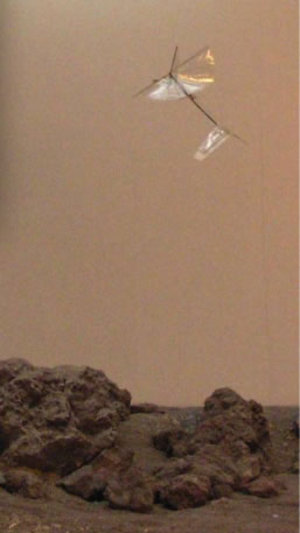This is perhaps the coolest thing I’ve ever seen. Ray Villard, the news director for the Hubble Space Telescope, also writes a blog for Discovery called Cosmic Ray (love that name!) He recently wrote about a dragonfly-like robotic device being developed by the Technical University Delft, Wageningen University in the Netherlands. It’s call the ExoFly, and Ray described it as a “dragonfly-on-steroids … a nimble flapping aerobot.” It could be the next generation of robotic planetary explorers. It’s a small, lightweight autonomous machine capable of flying, hovering, landing and taking off like an insect. Ray says this type of vehicle would “open up a new exploration niches that it not easily reachable by rovers or airborne vehicles on far flung worlds.” Actually, it might work best in conjunction with a future big rover, flying ahead to search for interesting or dangerous terrain, and the rover would provide a “landing pad” for the ExoFly’s home base. While the ExoFly may be small, its name sounds like a potential super hero, and its capabilities could be in the exploration super hero category, as well.
Take a look at the incredible video of the ExoFly below:
The ExoFly would be great for exploring Mars, and Titan, too. Small onboard cameras would provide a unique overhead but close-up view of the terrain in geological terms that would be different from, and could compliment, a rover.
The prototype ExoFly weighs less than an ounce, has a wingspan of only a foot, and can fly for 12 minutes on batteries.
A Mars ExoFly would need a longer wingspan and carry a miniaturized high-resolution digital video camera, sensors, navigation system and instruments.
Check out all of Ray Villard’s ideas for this future flying robot at Cosmic Ray.
Image and video credit: T.E. Zegers
Source: Cosmic Ray (with a head nod to Disco Dave Mosher for his Twitter Tweet)


Thanks Nancy!
WHOOOAAAAAAAAAAAAA!!! BRILLIANT!!!
Wow! This is topping the scale of cool, together with that big quadruped robot that made the news a few months ago!
I’m confused about one thing, though. You wrote that one of the main pluses of this robot would be “flying ahead to search for interesting or dangerous terrain”. But isn’t that what orbiters are being used for? That and relaying communications with Earth? What wold this dragonbot do the next generation of orbiters wouldn’t be able to do?
THAT
IS
AWESOME
I want one right now.
Very much enjoy your journalism, however I can’t help but correct:
“It could [be] the next generation of robotic planetary explorers.”
Thanks for the eagle eyes Frank! It’s been fixed.
Nancy
Incredible! Let’s hope it stays with science and away from the military. Hate to see a swarm of these things dropping grenades.
I saw videos of this little flying robot recently. This is the worst flyer I have ever seen. It was equipped with a tiny wireless video camera, and the video it sent was the worst I have ever seen.
The robot must be very lightweight to be able to fly with very little power for a long time. Therefore batteries are very small, so there is very little power available to run controls, the engine and the video camera.
The robot was built as a tiny silent spy-out device for military and private surveillance.
Regards,
Günther
Mars has 1% of Earth’s atmosphere….
I’m pretty sure there’s an episode of X-files that postulates robots designed to function as insects would be the next big wave in space exploration. X-files: 1 Nostradamus: 0